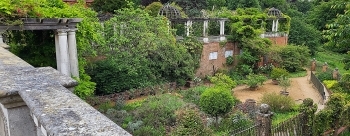An almost hidden treasure on London’s Hampstead Heath
ANYONE TRAVELLING BY ROAD along North End Way between Hampstead’s Whitestone Pond and Golders Green will pass Inverforth House (on the west side of the road). Now used as a luxury apartment house, the place has an interesting history and an even more interesting garden, some of which is open to the public.

Here is what I wrote about this property in my book “Beneath a Wide Sky: Hampstead and its Environs” (available from Amazon):
“Inverforth Close, a small private road open to pedestrians, leads off North End Way. At the end of it, there is a delightful garden with a wooden pergola, The Hill Garden, which is open to the public. It was once part of the gardens of Inverforth House. The present house was built in 1895 in a ‘neo-Georgian’ style to the designs of the architectural practice of Grayson and Ould. Between 1896 and 1904, Ronald Fisher (1890-1962) lived there as a child. He was one of the ‘fathers’ of modern biological statistics.
Between 1904 and 1925, the house was owned by William Lever, Viscount Leverhulme (1851-1925). He was one of the first men to produce soap on an industrial scale (in 1884) and was an enlightened industrialist. He built Port Sunlight near to Birkenhead to house his workers in pleasant surroundings. The house’s library was designed by built by William and Segar Owen of Warrington, who also designed buildings at Port Sunlight. In 1955, Inverforth House became a convalescent home of the (now closed) Manor House Hospital, and that is how I remember it from my childhood. The hospital was not part of the NHS. It was privately run by trade unions. The edifice ceased being a hospital in 1999. Now, the house contains privately owned, luxury flats; it has become a ‘gated community’.
The gardens of Inverforth House were laid out from 1906 onwards by Thomas Hayton Mawson (1861-1933), garden designer, landscape architect, and town planner. According to one source (www.historic-uk.com), Lord Leverhulme wanted the pergola:
‘…to be the setting for extravagant Edwardian Garden parties, while at the same time being a place where his family and friends could spend long summer evenings enjoying the spectacular gardens.’
In 1960, the London County Council (‘LCC’) bought the Pergola and associated garden areas, which had by then become very dilapidated. In 1963, part of the gardens was opened to the public, and called the ‘Hill Garden’…”
Today, the 12th of June 2024, we re-visited the pergola. We had not been there for at least 10 years. Most of the long pergola (about 300 yards in length) was open to the public – more than in the past, it seemed to us. Although some of the timber trellising, which is supported by stone pillars, was looking rather weatherbeaten, walking along the raised paths was a delight because of the flowering bushes blooming all along it. From the pathway, one gets good views over Hampstead Heath and into the well-manicured private grounds of Inverforth House.
Many locals and people who used to be locals in Hampstead and Golders Green know about the Pergola and the Hill Garden next to it. However, when you reach it, you are sure to get the pleasurable feeling that you have discovered a secret garden, and unless you suffer from hay fever (and have not taken antihistamines), a wonderful experience awaits you.



